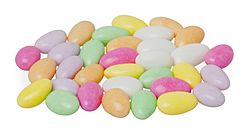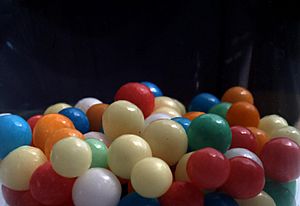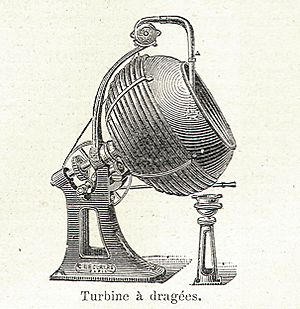Dragée facts for kids

A form of dragée: Jordan almonds
|
|
| Type | Confectionery |
|---|---|
A dragée (say "dra-ZHAY") is a small, bite-sized candy. It has a hard outer shell, often made of sugar. People use dragées for more than just eating. They can be decorative, symbolic, or even used for medicine. You might also hear them called confetto or Jordan almond.
Contents
Types of Dragées
Jordan Almonds: Sweet Traditions
One of the most famous types of dragées is the Jordan almond. These are almonds covered in a sweet, hard sugar coating. They come in many soft, pastel colors.
Jordan almonds are very popular for wedding favors, especially in Italy and Greece. They are often called koufeta. The "bitter" almond and "sweet" sugar show the ups and downs of life and the sweetness of love.
At weddings, these candies are often given in groups of five. Each almond stands for something important: happiness, health, a long life, wealth, and fertility. Five is an odd number, which can't be divided. This symbolizes the strong unity of the husband and wife.
Where Did Jordan Almonds Come From?
People think Jordan almonds started in ancient Rome. A baker named Julius Dragatus made almonds covered in honey. These were called dragati and were served at important events like weddings. Later, in the 1400s, sugar became easier to find. So, people started coating the nuts with sugar instead. In Sulmona, Italy, the Pelino family became very skilled at making these sugar-coated almonds.
The name "Jordan" might come from the French word jardin, meaning "garden". This would mean it's a cultivated almond, not a wild one. Another idea is that the name comes from a type of almond grown near the Jordan River. These almonds were known for being long and smooth.
Some also believe "Jordan" comes from the French town of Verdun. In the 1200s, crusaders brought sugar to Europe. It was very valuable and used as medicine. An apothecary (like a pharmacist) in Verdun started coating medicines with sugar. He called them dragées to make them easier to take. The town of Verdun became famous for its dragées de Verdun.
Chocolate Dragées
Another common type of dragée is chocolate covered in a hard candy shell. A great example is M&M's! They were first made so soldiers could carry and eat chocolate easily without it melting. Now, they are a popular candy and are also used for decorating.
Easter Treats
In Portugal, sugared almonds are a very traditional treat for Easter. They are often given as gifts instead of chocolate eggs. Before Easter, you can find whole sections of supermarkets filled with them!
Medicinal Dragées
Sometimes, medicines taste bitter or are hard to swallow. To help with this, pills can be coated with sugar. These sugar-coated pills are also called dragées. The coating makes the medicine easier to take.
Metallic Decorative Balls
Another kind of dragée is a small, round sugar ball. In some countries, they are called cachous. People use them mainly to decorate cookies, cakes, and other baked goods. They come in different sizes, usually about 3 to 4 millimeters wide.
Silver dragées have been used for a long time to decorate wedding and holiday foods. Now, you can also find them in gold, copper, rainbow colors, and pearly colors.
In most countries, like the United Kingdom and France, silver dragées are considered food. However, in the United States, rules from 1906 say you can't sell food with metal or mineral substances as coloring or coating. So, the U.S. Food and Drug Administration says metallic-finish sugar dragées are not meant to be eaten. They can only be sold if they say they are for decoration only.
See also
 In Spanish: Peladilla para niños
In Spanish: Peladilla para niños
|




